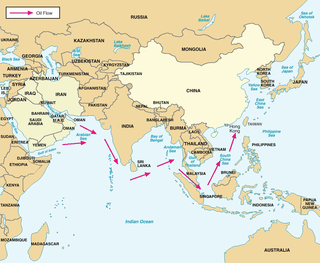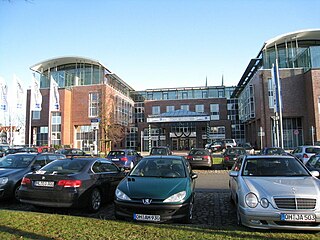
A container ship is a cargo ship that carries all of its load in truck-size intermodal containers, in a technique called containerization. Container ships are a common means of commercial intermodal freight transport and now carry most seagoing non-bulk cargo.

Panamax and New Panamax are terms for the size limits for ships travelling through the Panama Canal. The limits and requirements are published by the Panama Canal Authority (ACP) in a publication titled "Vessel Requirements". These requirements also describe topics like exceptional dry seasonal limits, propulsion, communications, and detailed ship design.

A cargo ship or freighter is a merchant ship that carries cargo, goods, and materials from one port to another. Thousands of cargo carriers ply the world's seas and oceans each year, handling the bulk of international trade. Cargo ships are usually specially designed for the task, often being equipped with cranes and other mechanisms to load and unload, and come in all sizes. Today, they are almost always built of welded steel, and with some exceptions generally have a life expectancy of 25 to 30 years before being scrapped.

A bulk carrier or bulker is a merchant ship specially designed to transport unpackaged bulk cargo—such as grain, coal, ore, steel coils, and cement—in its cargo holds. Since the first specialized bulk carrier was built in 1852, economic forces have led to increased size and sophistication of these ships. Today's bulk carriers are specially designed to maximize capacity, safety, efficiency, and durability.

A tanker is a ship designed to transport or store liquids or gases in bulk. Major types of tankship include the oil tanker, the chemical tanker, cargo ships, and a gas carrier. Tankers also carry commodities such as vegetable oils, molasses and wine. In the United States Navy and Military Sealift Command, a tanker used to refuel other ships is called an oiler but many other navies use the terms tanker and replenishment tanker. Tankers were first developed in the late 19th century as iron and steel hulls and pumping systems were developed. As of 2005, there were just over 4,000 tankers and supertankers 10,000 LT DWT or greater operating worldwide.

Capesize ships are the largest dry cargo ships with ball mark dimension: about 170,000 DWT capacity, 290 m long, 45 m beam (wide), 18m draught. They are too large to transit the Suez Canal or Panama Canal, and so have to pass either Cape Agulhas or Cape Horn to traverse between oceans.
The Baltic Dry Index (BDI) is a shipping freight-cost index issued daily by the London-based Baltic Exchange. The BDI is a composite of the Capesize, Panamax and Supramax timecharter averages. It is reported around the world as a proxy for dry bulk shipping stocks as well as a general shipping market bellwether.

Malaccamax is a naval architecture term for the largest tonnage of ship capable of fitting through the 25-metre-deep (82 ft) Strait of Malacca. Bulk carriers and supertankers have been built to this tonnage, and the term is chosen for very large crude carriers (VLCC). They can transport oil from Arabia to China. A typical Malaccamax tanker can have a maximum length of 333 m (1,093 ft), beam of 60 m (197 ft), draught of 20.5 m (67.3 ft), and tonnage of 300,000 DWT.

Handysize is a naval architecture term for smaller bulk carriers or oil tanker with deadweight of up to 50,000 tonnes, although there is no official definition in terms of exact tonnages. Handysize is also sometimes used to refer to the span of up to 60,000 tons, with the vessels above 35,000 tonnes referred to as Handymax or Supramax.

An LNG carrier is a tank ship designed for transporting liquefied natural gas (LNG).

An oil tanker, also known as a petroleum tanker, is a ship designed for the bulk transport of oil or its products. There are two basic types of oil tankers: crude tankers and product tankers. Crude tankers move large quantities of unrefined crude oil from its point of extraction to refineries. Product tankers, generally much smaller, are designed to move refined products from refineries to points near consuming markets.
Oshima Shipbuilding Co., Ltd. is a privately held Japanese shipbuilding company. The company was founded on February 7, 1973, and began operations in June 1974. It is a joint venture between Sumitomo Corporation, Sumitomo Heavy Industries, and the Daizo Corporation.
The H. Vogemann Group is a German shipping company. Founded in 1886, the company is privately owned by its managing partners and its fleet of bulk carriers has a capacity of more than 1.5 million tonnes deadweight (DWT).

Sanoyas Hishino Meisho Corporation is a Japanese company that consists of four principal business groups and twelve affiliated companies. The business groups are: the Ship and Steel Structure Group, the Parking System & Engineering Group, the Construction Machines Group, and the Leisure Business Group.
Portline Transportes Marítimos Internacionais, SA., often simply called Portline is a Portuguese shipping company. The company has diverse business activities, including dry bulk, containerised, and break-bulk cargo shipping, shipping agency, forwarding and logistics services, ship management and manning, ship brokerage and chartering, and a container depot service.

Excel Maritime Carriers Ltd. is a shipping company specializing in the transport of dry bulk cargo such as iron ore, coal and grains, as well as bauxite, fertilizers and steel products. As of May 2009, it is the largest bulk carrier by DWT of any U.S.-listed company. Approximately one-third of all seaborne trade is dry bulk related. Excel Maritime was a component of the NYSE Composite Index and the PHLX Marine Shipping Index. The stock has been de-listed from the exchanges as per their rules of listing

Chinamax is a standard of ship measurements that allow conforming ships to use various harbours when fully laden, the maximum size of such a ship being 24 m (79 ft) draft, 65 m (213 ft) beam and 360 m (1,180 ft) length overall. An example of ships of this size is the Valemax bulk carriers.
J. Lauritzen(JL) is a Danish shipping company with worldwide operations headquartered in Hellerup, Denmark. JL is a private company wholly owned by the Lauritzen Foundation, a Danish commercial foundation that is also the main shareholder (around 40%) of DFDS, one of Europe's largest ferry shipping and logistics company.

The Haldia Port, officially Haldia Dock Complex (HDC), is a port on the confluence of the Haldi River and the Hooghly River. The port is located at Haldia in West Bengal, about 130 kilometres (81 mi) from the sandheads–deep sea area of the Bay of Bengal, 45 kilometres (28 mi) upstream from Pilotage Station at Sagar and 104 km downstream of Kolkata. In 1968, an oil jetty was commissioned at Haldia, and officially in 1977 the port facility of Haldia started functioning as a subsidiary port of the Port of Kolkata under the name Haldia Dock Complex.

Oldendorff Carriers is a family owned shipping company with headquarters in Lübeck.














